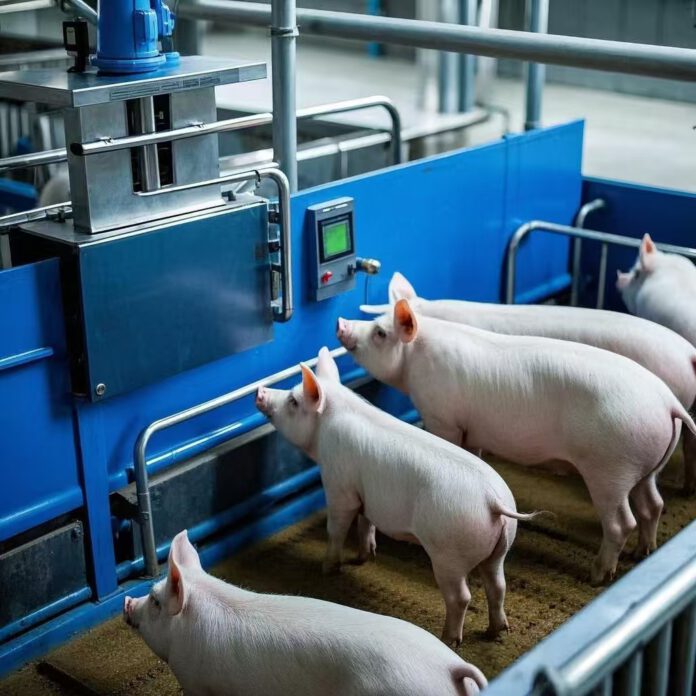
“If you can raise pigs well in China, you can raise them well anywhere in the world,” says Yang Jun, Vice Chairman of Charoen Pokphand (CP) Group’s Agriculture and Food Division in China and President of the Zhanjiang and Hainan regions. Yang explains that China presents some of the toughest conditions for pig farming in the world, with immense pressure from disease prevention, environmental and land-use restrictions, and a high reliance on imported feed resources. Yet, through rapid technological advancements, CP Group is proving that these challenges can be overcome—one by one.
Today, CP Group’s smart pig farms require only five workers to manage 30,000 pigs. Consumers can trace the entire journey of the pork they buy—from birth to plate—by scanning a single QR code. Behind the scenes, 5G networks serve as the digital backbone, integrating IoT, AI, and blockchain technologies to automate and optimize every step of the farming process. Real-time data is constantly analysed, generating detailed reports on critical metrics like pigs weaned per sow per year and feed efficiency, allowing for precise, data-driven decisions.
Across CP Group’s operations, a transformation is underway—from traditional, extensive farming to intelligent, digitised systems. The shift is best summed up by the phrase now common in the industry: “people maintain the equipment; the equipment takes care of the pigs.” And this is no exaggeration. On CP’s digital farm in Zhanjiang, pigs live in conditions more like smart villas than conventional pens. Air filtration systems, automatic pressure washing, and odour control technologies ensure optimal hygiene. Temperature and humidity are kept within the pigs’ comfort range, and all environmental indicators—from electricity use to water consumption—are monitored in real time via mobile devices. If anything goes wrong, the system sends immediate alerts.

Each pig is equipped with a personalised ear tag—a microchip that tracks body temperature, movement, and feeding behaviour. This data is uploaded to the cloud, where AI algorithms evaluate health status, detect early signs of illness, and assess development progress. Yang Jun explains that even changes in mood can be detected; pigs eating less than usual trigger alerts, allowing workers to intervene promptly. The same ear tag also serves as a kind of access pass for feeding: pigs can only enter feeding stations if their health data meets preset thresholds, ensuring feed is not wasted and each animal remains in ideal condition.
The financial benefits of this system are striking. According to Yang, CP’s smart farms save approximately 30 million yuan annually in feed and labour, while cutting water and electricity usage by about 5%, which translates to another 3 million yuan. Even more critically, disease prevention is vastly improved. Constant monitoring allows for early detection and isolation of infected animals, acting as a digital biosecurity barrier that significantly reduces the risk of widespread outbreaks.
CP has also fully embraced blockchain technology to ensure traceability throughout the supply chain. Every pig is tracked from birth to processing. As each enters the slaughterhouse, its serial number is automatically matched to a slaughter batch, and the corresponding pork products are tagged with a unique QR code. This enables consumers to access the entire history of their food—slaughter date, production line, and location—at the tap of a smartphone. This “one pig, one code” model has been a key part of CP’s commitment to food safety and transparency.
But technology isn’t the only innovation driving CP’s success. With China consuming around 700 million pigs annually, breeding has emerged as a major bottleneck in domestic pork production. In fact, 90% of pigs slaughtered in China each year are from foreign breeds. To address this, CP has worked with countries like Denmark and France to improve genetic stock, focusing on breeds that grow quickly, consume less feed, and yield high-quality lean meat. One result of this effort is the “Pineapple Pig,” a new breed developed using local resources. In Xuwen County—China’s largest pineapple producer—waste pineapple pulp is converted into nutritious feed using bio-fermentation. The pigs raised on this feed produce manure that is treated and turned into organic fertilizer, closing the loop in a fully circular farming model that supports both agriculture and livestock.
The pens themselves are designed with slatted floors, allowing waste to fall into underground channels. This waste is then transported through pipelines into biogas digesters, where it is fermented and separated. The nutrient-rich liquid is used to irrigate farmland, while the solid waste becomes fertilizer for crop production, further integrating CP’s pig farming into the local agricultural ecosystem.
CP Group’s vertically integrated model is now operating at a massive scale. In cities like Xiangyang, Luoyang, and Xuzhou, the company has built complete industrial chains covering breeding, farming, processing, and distribution. Its Gansu facility has been named a national Core Breeding Farm, and its hogs station has earned the title of China’s Most Influential Hogs Station. In 2020, Zhanjiang became home to China’s first blockchain-based pork traceability pilot, and in December 2021, the “Charoen Pokphand Pineapple Pork” brand launched its own themed high-speed rail service. With immersive branding and over 2 million passengers exposed annually, CP is turning pork into a lifestyle brand—linked to trust, safety, and innovation.

The industrial park in Zhanjiang now features a feed mill with an annual output exceeding 300,000 tonnes and a processing facility capable of handling one million pigs per year. CP has also expanded into ready-to-eat products, including crispy pork belly, char siu, and pineapple pork sausages, all of which have quickly gained consumer popularity.
Today, CP’s Suixi hub anchors a network of 80 industrial bases across Leizhou, Lianjiang, Wuchuan, and beyond. Each is equipped with standardised smart systems, supporting a combined annual production capacity of over one million pigs. All of this aligns with Guangdong Province’s targets, which include maintaining a sow inventory of around 1.9 million head and ensuring more than 5,000 large-scale pig farms remain operational. With a pork self-sufficiency goal of over 70%, the region sees intelligent pig farming not just as an economic upgrade, but as a strategic imperative for food security.
Source: chinafeedm, 21jingji, cpcti



